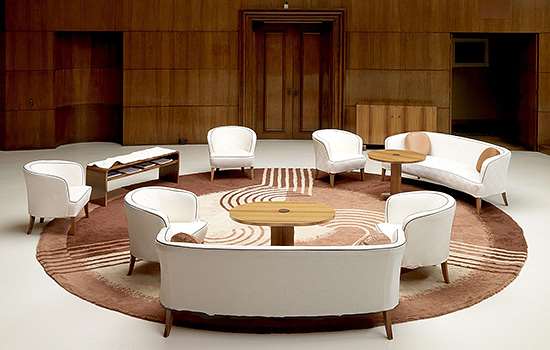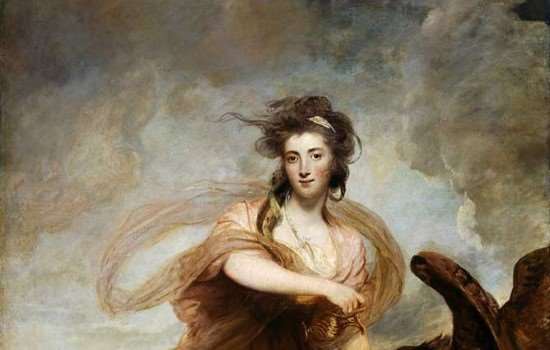The Brooches
When the Courtaulds obtained the lease on Eltham in 1933, they set out to simultaneously build a modern home with cutting-edge technology and restore the medieval Great Hall, originally built by Edward IV in the 1470s.
The building works were a long and painstaking labour of love for the couple.
The windows of the restored Great Hall were installed in 1936 and the Cartier jewels were presented to Virginia around 1936–7. Therefore, it is highly likely the gift was intended to mark the date when the Courtaulds finished work on their new home. As no surviving receipts have been discovered, it is unknown how much Stephen paid for these unique made-to-order creations, but the use of precious stones including diamonds, pink tourmaline, sapphire and citrine, alongside the Cartier name, means we can assume the commission would have been a considerable amount.
The brooches reproduce the cyphers of Edward IV in precious stones and gold, one with the rose en soleil (Tudor white rose against a star) and the other with the falcon in fetterlock (a sort of padlock or shackle common in heraldry). These same emblems are seen on the stained-glass windows of Eltham’s Great Hall, which the Courtaulds commissioned from George Kruger Gray.
Like their new home, the brooches are an elegant combination of history (in form of the symbols of Edward IV) and modernity in the choice of the coloured stones.
Cartier London
The Cartier name was synonymous with elegance, exclusivity and fine craftsmanship. In the 1930s, it was a global brand having stores in Paris, London and New York.
In London, the first boutique opened at 4 Burlington Street in 1902, subsequently moving to 175 New Bond Street in 1909, where the store remains today. The opening of the London store was the firm’s response to an overwhelming amount of commissions from the British aristocracy, who were keen to sport fine jewellery for the coronation of Edward VII that same year.
Cartier had an established relationship with the royal family, from which it received its first Royal Warrant in 1904. Originally a stockist for goods made in Paris, the establishment of workshops with English craftsmen above the London store led to the birth of a distinct British style.
Throughout the 1930s, fashion magazines like Vogue featured Cartier jewellery in photoshoots, while monarchs and celebrities were regularly wearing the firm’s creations at events. The commission of these brooches to Cartier highlights not only the Courtaulds’ taste and wealth, but also their social standing. Queen Mary, who was wearing Cartier jewellery at the time, is known to have visited the Courtaulds at Eltham in 1935 and 1938. It is likely that Virginia wore the brooches while entertaining friends in the Great Hall, where the reference to the architecture would be obvious to guests.
Image: Cartier London shop front in New Bond Street, photographed in 1910 © Historic England Archive
A Surprising Discovery
In 2025, after the acquisition of the brooches by English Heritage, it was discovered that the jewels had originally been commissioned as pendant earrings, with the emblems dangling from a short string of three pearls on each earring. Looking at other contemporary earrings produced by Cartier, it seems an unusual choice to commission a pair of earrings that did not match.
Considering their gross weight of 27.1 grams, it is likely that Virginia found them too heavy and uncomfortable to wear and so converted them into brooches shortly after Stephen gifted them to her.
While we can imagine a pair of odd earrings working well with Virginia’s eccentricity, the conversion to brooches allowed her more flexibility when wearing them. Brooches were popular in the 1930s, as they could be combined in many ways with the wearer’s clothing. From a hat embellishment to a strap fastener on an evening dress, these jewels offered endless practical and decorative opportunities.
Returning to Eltham
Apart from a brief mention in a book Eltham Palace by John Priestley (published 2008), the brooches were largely unknown throughout their history. After Virginia’s death, they passed to one of her close friends and then by descent to the friend’s granddaughter, who put them on sale at auction.
Generous help from the Art Fund and the Wolfson Foundation allowed English Heritage to acquire the brooches in 2024. They are now part of the permanent collection at Eltham and on display for the public’s enjoyment.
You can see the brooches on display in the Minstrel’s Gallery, right next to the stained-glass windows that inspired their design.
Explore more
-

Visit Eltham Palace
Millionaire life in an art deco mansion
-

History of Eltham Palace
Learn about the history of this unique palace before the Army took up residence, from its medieval origins to the 1930s.
-

Collection Highlights
Explore of the collection at Eltham here including works of fine and decorative art collected from all over the world by the Courtaulds.
-

Our Collections
Discover more of the collections from our sites from archaeological material, decorative arts and weaponry to our world-class selection of fine art.
